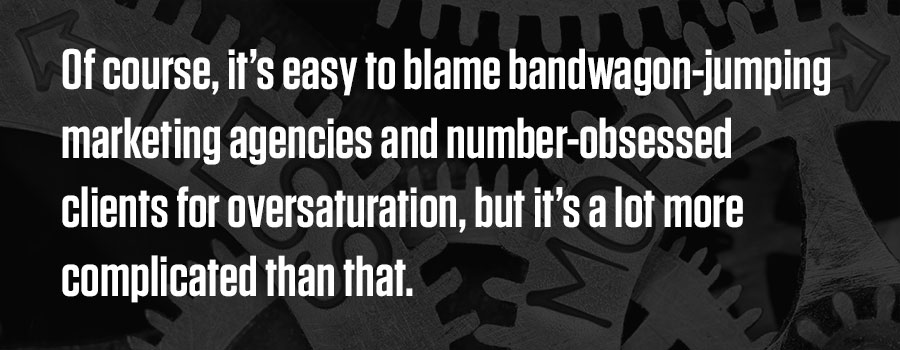
We Need Less-Is-More Marketing, And A Lot Of It
Niles: Do we really have to use so many musicians?
Frasier: For the sound I want, yes.
Niles: Whatever happened to the concept of "less is more"?
Frasier: Ah, but if less is more, just think of how much more "more" will be.
(From “Frasier” — episode: “They’re Playing Our Song”)
In the episode quoted above, Frasier goes waaay over the top when asked to compose a jingle for his show, composing a 30-second choral symphony packed with every musical instrument, and every vocal and lyrical trick in the book. In the end, Martin’s alternative, a simple, three-line jingle, wins over the stupefied station manager and inspires Frasier to take about 1,000 steps back and craft a much simpler tune that works perfectly for the show.
Marketing by the numbers creates too much stuff.
This “Frasier” episode is a great analogy for what can go wrong with online marketing. When something works, such as blogging, everybody jumps on the bandwagon — and pretty soon, the genuineness, depth and informality of blogging, which were key attractions, get lost under an ever-growing mountain of fluff and overpromotion. We ended up in a state of what Mark Schaefer famously called “content shock,” and I’d say we’ve moved on from that to where we are now, in an outright content coma.
There’s just too much stuff. Too many blog posts, too many emails, too many ads, too many links, too many online reviews, too many tweets, too many social ads. Whatever starts as a catchy, effective jingle ends up as an overproduced symphony with everybody trying blow his own horn.
Clients naturally gravitate to marketing by the numbers. Businesses like things that can be measured. If 10 inbound links are good, 20 are better. If a 1,000-address mailing list is good, a 2,000-address list is better. If a 50-page website is good, a 100-page website is better.
More means progress. Or does it?
The problem, of course, is that when everybody is doing more, the law of diminishing returns kicks in. If 10 inbound links did you “y” amount of good five years ago, you probably need 100 today just to stay even. If one great blog post got you a lot of traffic five years ago, you probably need 20 great posts today to stay even. Where does it end?

It’s not us, it’s you.
Of course, it’s easy to blame bandwagon-jumping marketing agencies and number-obsessed clients for oversaturation, but it’s a lot more complicated than that. The online marketing environment has built-in incentives that drive overproduction.
Google promotes overproduction in its search algorithm. We are told that inbound links are an important ranking factor — so naturally, companies investing in SEO want more of them. Chasing links creates more content, which Google is perfectly happy to index and rank. More indexed content means more search queries, which means more demand and higher prices for ads. It’s how Google makes money. For Google, more is more.
Similarly, social media platforms can’t seem to go wrong with more users and more content. All the millions or billions of users and posts dazzle advertisers. Where will it end — with everyone checking their social media streams 24/7? Judging by the number of distracted drivers I see every day and people whose cellphones are welded to one of their hands, that day may not be as far off as you think.
One might think that marketing agencies are also happy to execute more-is-more marketing, as more work equals higher billings. However, there is a problem. Clients pay for marketing in order to get revenue and sales leads. At some point, their number fixation gives way to an observation such as, “True, website traffic is up 350 percent, but we’re not getting more leads.” Without revenue or leads, ever-increasing campaign stats don’t amount to a hill of beans; when clients see this, they stop spending on campaigns and/or find another agency.
How do we get to less-is-more marketing?
Instead of chasing more, is it possible for online marketers to chase less? Certainly, it’s a tough assignment given the biases of Google and social platforms that I just described. Nevertheless, there are steps agencies can take. Please add to the list if you have suggestions!
- Edit more. Great editing simplifies and streamlines content, any content.
- Publish less. Just because it was created doesn’t mean it’s worth publishing. Set strict editorial standards; if the content doesn’t measure up, give it further edits or send it to the circular file.
- Experiment. It’s hard to stand out when you’re doing the same thing everybody else is doing. A percentage of every marketing campaign should involve testing new ideas. Worried about testing with clients? Use your own marketing as your ideas lab.
- Be more strategic. Carpet bombing keywords is a questionable strategy for SEO. Better would be zeroing in on a smaller set of target keywords most likely to produce the conversions that sustain a campaign long-term. Social and email campaigns that pinpoint target audiences and streamline messaging strategies also beat incessant, mixed messages to anyone and everyone.
- Put more emphasis on CRO and UX. These two disciplines are so important. If a client’s website is built for conversion, all forms of online marketing will get more and better conversions. This reduces the temptation to carpet bomb, and ultimately gives the client far more value for its marketing investment.
In closing, avoid marketing like this:
Instead, shoot for this:




